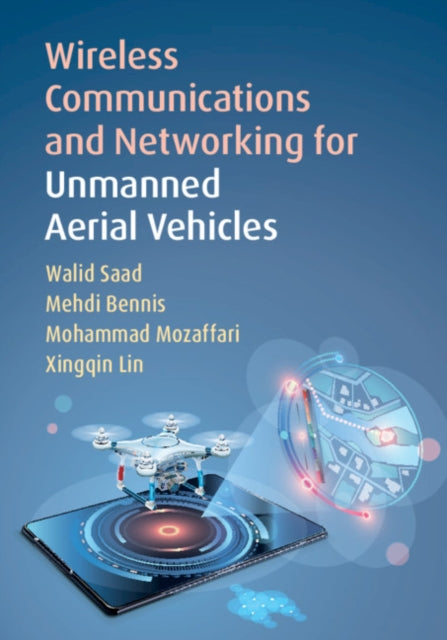WalidSaad,MehdiBennis,Mohammad Mozaffari,Xingqin Lin
Wireless Communications and Networking for Unmanned Aerial Vehicles
Wireless Communications and Networking for Unmanned Aerial Vehicles
YOU SAVE £24.69
- Condition: Brand new
- UK Delivery times: Usually arrives within 2 - 3 working days
- UK Shipping: Fee starts at £2.39. Subject to product weight & dimension
Bulk ordering. Want 15 or more copies? Get a personalised quote and bigger discounts. Learn more about bulk orders.
Couldn't load pickup availability
- More about Wireless Communications and Networking for Unmanned Aerial Vehicles
UAV wireless communications and networking research challenges and opportunities are discussed, with a focus on practical applications such as drone delivery systems, public safety, IoT, virtual reality, and smart cities.
\n Format: Hardback
\n Length: 530 pages
\n Publication date: 02 April 2020
\n Publisher: Cambridge University Press
\n
Unmanned Aerial Vehicles (UAVs) have emerged as a promising technology for a wide range of applications, from aerial surveillance and photography to delivery services and remote sensing. However, the development of UAV wireless communications and networking research faces several challenges and opportunities. In this comprehensive treatment, we will explore these challenges and opportunities in detail, providing a step-by-step development of carefully selected research problems that pertain to UAV network performance analysis and optimization, physical layer design, trajectory path planning, resource management, multiple access, cooperative communications, standardization, control, and security.
One of the key challenges in UAV wireless communications is the limited bandwidth and power resources available in the air. UAVs typically operate at low altitudes, where the signal strength is weak, and the interference from other wireless devices is high. This requires the development of efficient communication protocols that can maximize the use of available resources while ensuring reliable communication.
Another challenge is the dynamic nature of UAV operations, which requires real-time communication and coordination between multiple UAVs. This requires the development of distributed control and coordination algorithms that can handle the uncertainty and variability of the air environment.
Physical layer design is another critical aspect of UAV wireless communications. UAVs operate in a wide range of environments, from urban areas to remote forests, and the characteristics of the communication channels vary accordingly. This requires the development of robust and reliable communication protocols that can adapt to different environmental conditions.
Trajectory path planning is another important aspect of UAV operations, as it determines the flight path of the UAV and affects its communication performance. This requires the development of efficient algorithms that can optimize the trajectory path while minimizing the energy consumption and communication overhead.
Resource management is another challenge in UAV wireless communications, as UAVs typically have limited battery life and computational power. This requires the development of energy-efficient communication protocols and algorithms that can maximize the use of available resources while ensuring reliable communication.
Multiple access is another critical aspect of UAV wireless communications, as it allows multiple users to share the same communication resources. This requires the development of efficient communication protocols that can support multiple access modes, such as time division multiplexing (TDM) and code division multiplexing (CDM).
Cooperative communications is another important aspect of UAV wireless communications, as it allows multiple UAVs to work together to achieve a common goal. This requires the development of distributed communication algorithms that can handle the uncertainty and variability of the air environment.
Standardization is another challenge in UAV wireless communications, as there is no standardization framework for UAV communication protocols and technologies. This requires the development of open-source platforms and standards that can facilitate the development and deployment of UAV communication systems.
Control and security are also critical aspects of UAV wireless communications, as UAVs are vulnerable to cyber-attacks and other security threats. This requires the development of secure communication protocols and algorithms that can protect the privacy and integrity of the communication data.
Practical applications of UAV wireless communications include drone delivery systems, public safety, Internet of Things (IoT), virtual reality, and smart cities. Drone delivery systems use UAVs to deliver goods and services to remote areas, providing a cost-effective and efficient alternative to traditional delivery methods. Public safety applications use UAVs to monitor and respond to emergencies, such as natural disasters and terrorist attacks. IoT applications use UAVs to connect devices and sensors in remote areas, enabling the collection and analysis of data for various applications. Virtual reality applications use UAVs to provide immersive experiences to users in remote areas. Smart cities use UAVs to monitor and manage traffic, infrastructure, and environmental resources, improving the efficiency and sustainability of urban areas.
In conclusion, UAV wireless communications and networking research faces several challenges and opportunities. By developing efficient communication protocols, distributed control and coordination algorithms, robust physical layer designs, and practical applications, we can overcome these challenges and realize the full potential of UAVs in a wide range of applications. This comprehensive treatment provides an essential tool for researchers, students, and engineers interested in broadening their knowledge of the deployment and operation of communication systems that integrate or rely on unmanned aerial vehicles.
\n Weight: 714g\n
Dimension: 182 x 252 x 19 (mm)\n
ISBN-13: 9781108480741\n \n
This item can be found in:
UK and International shipping information
UK and International shipping information
UK Delivery and returns information:
- Delivery within 2 - 3 days when ordering in the UK.
- Shipping fee for UK customers from £2.39. Fully tracked shipping service available.
- Returns policy: Return within 30 days of receipt for full refund.
International deliveries:
Shulph Ink now ships to Australia, Belgium, Canada, France, Germany, Ireland, Italy, India, Luxembourg Saudi Arabia, Singapore, Spain, Netherlands, New Zealand, United Arab Emirates, United States of America.
- Delivery times: within 5 - 10 days for international orders.
- Shipping fee: charges vary for overseas orders. Only tracked services are available for most international orders. Some countries have untracked shipping options.
- Customs charges: If ordering to addresses outside the United Kingdom, you may or may not incur additional customs and duties fees during local delivery.


